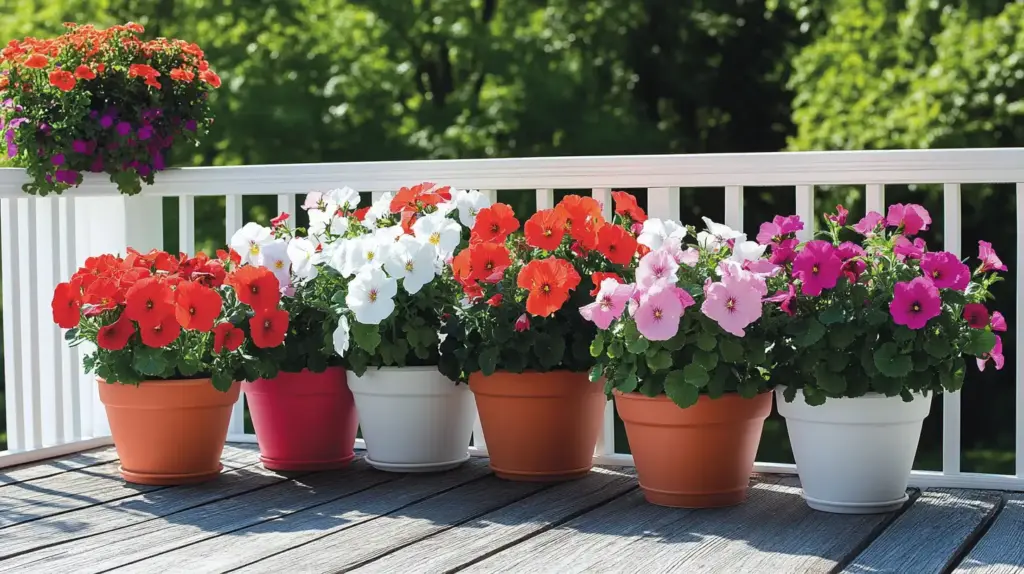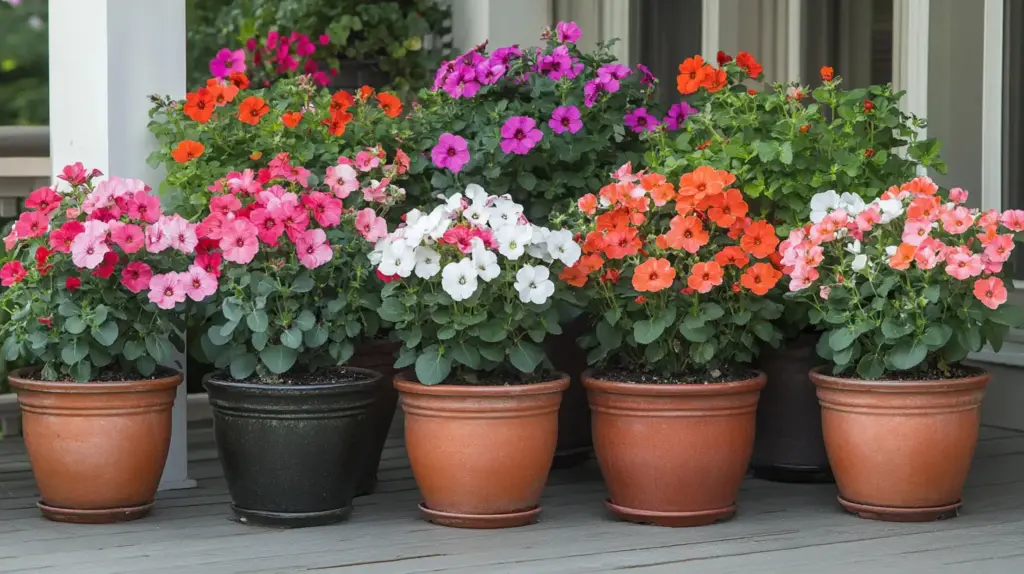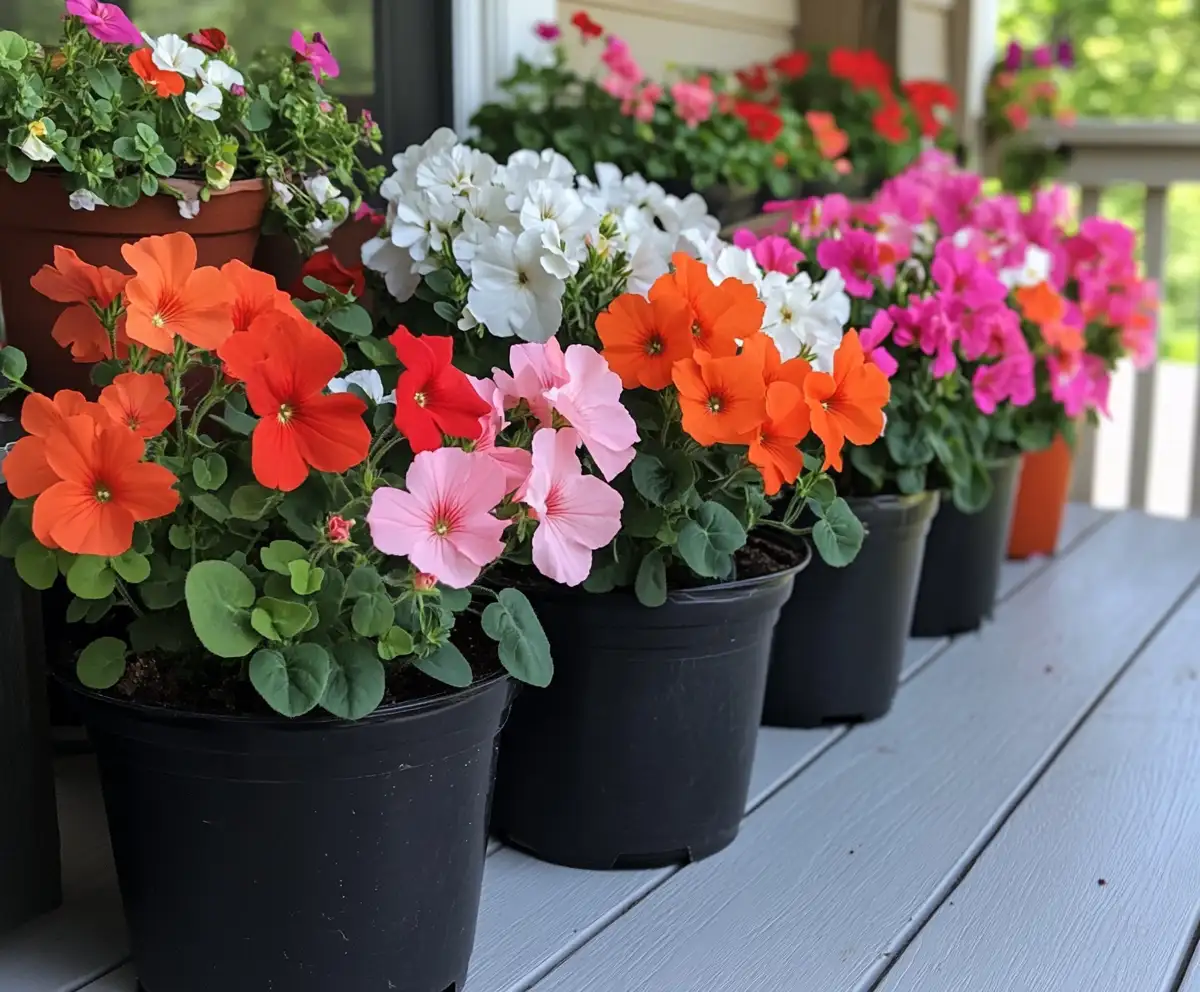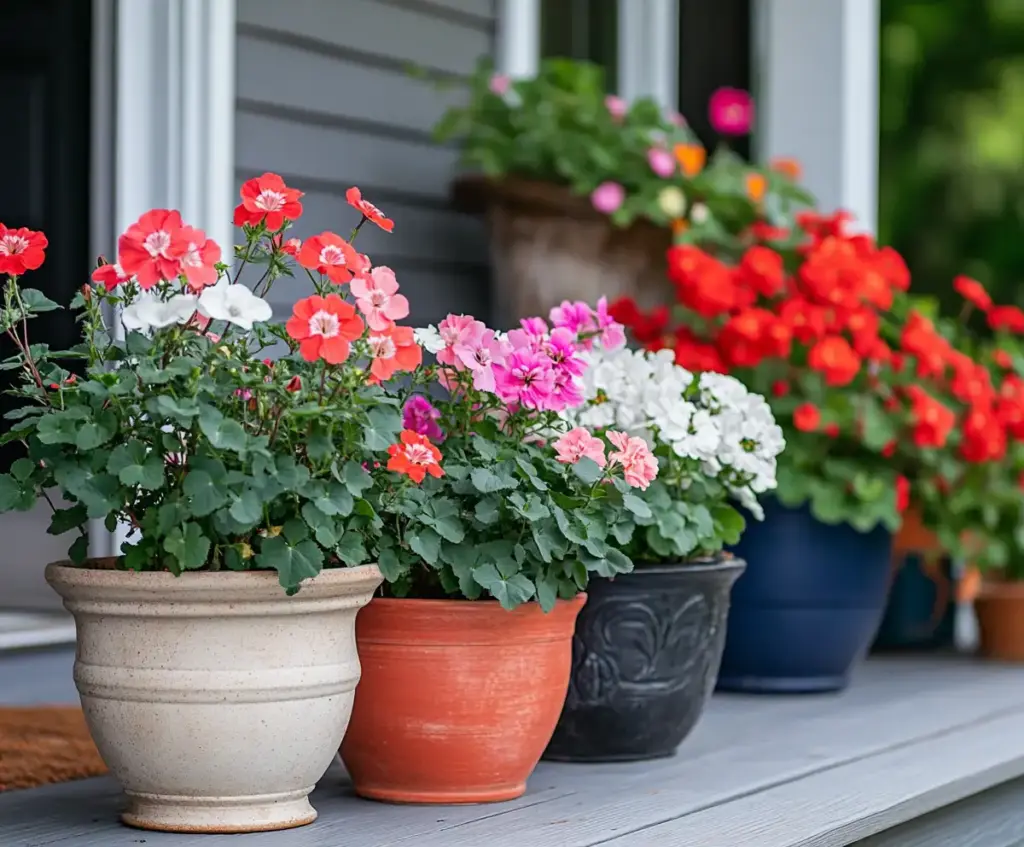Growing begonias in pots is one of the most rewarding ways to add vibrant, textured color to your container garden. These stunning plants are loved for their lush foliage and dazzling blooms, making them a go-to choice for gardeners who want big visual impact with manageable care. Whether you’re brightening a sunny balcony, refreshing a shaded patio, or decorating a bright windowsill, growing begonias in pots offers a versatile and visually captivating option.
What makes growing begonias in pots especially appealing is their ability to thrive in compact spaces — just like many of the best outdoor potted plants for summer featured on our site. From cascading begonias ideal for front porch flower pots to upright varieties that work beautifully in modern front yard landscaping ideas, these plants can transform both indoor and outdoor areas with ease.
For gardeners seeking low-maintenance outdoor potted plants, begonias check all the boxes — they’re adaptable, low-fuss, and deliver nonstop charm. Whether paired with hostas in containers for lush foliage contrast or featured in a collection of sun-loving container blooms, growing begonias in pots is a simple way to create beauty that lasts from spring to fall.
🌿 Love gardening inspiration? Follow me on Pinterest for bold plant ideas, tips, and seasonal color!
Table of Contents
🌱 1. Understanding Begonias
Before diving into container prep and soil choices, it helps to understand what makes begonias such a versatile and rewarding plant. The begonia family includes over 1,800 species and countless hybrids, giving gardeners a stunning array of options — from bold foliage patterns to a rainbow of bloom colors.
One signature trait of begonias is their asymmetrical leaves, often shaped like angel wings or seashells, adding visual texture to any pot. The flowers range from delicate pastels to fiery reds and oranges, with single or double blooms depending on the variety.
Begonias are broadly classified into three main types:
- Fibrous-rooted begonias: Great for bedding and containers; they bloom nonstop and are low-maintenance.
- Tuberous begonias: Known for large, showy flowers and trailing forms perfect for hanging baskets.
- Rhizomatous begonias: Valued more for their unique leaves than their blooms; ideal for indoor growing.
Thanks to their adaptability, begonias flourish in both humid and temperate climates, making them ideal candidates for container gardening across various regions.
🪴 2. Selecting the Right Container

Choosing the right container is a foundational step in successfully growing begonias in pots. A well-suited pot not only supports healthy root development but also reduces maintenance and helps prevent common issues like root rot.
Here’s what to consider when picking the perfect pot:
✅ Size Matters
Begonias need room to grow, especially if you’re planting fibrous or tuberous types with spreading root systems. Select a pot that’s at least 8–12 inches in diameter to accommodate mature plants. For smaller varieties or indoor displays, even a 6-inch pot will do — just be prepared to repot as the plant outgrows it.
✅ Drainage is Non‑Negotiable
Poor drainage is the fastest way to lose a begonia. Always choose containers with multiple drainage holes to allow excess water to escape. If you fall in love with a pot that lacks holes, drill some yourself or use it as a decorative outer container (cachepot) with a plastic nursery pot inside.
✅ Best Pot Materials for Begonias
- Terracotta: Excellent for airflow and moisture regulation. These porous pots help prevent overwatering but may require more frequent watering in hot weather.
- Unglazed ceramic: Another breathable option that keeps roots happy.
- Plastic or resin: Lightweight and affordable but less breathable. Make sure it has ample drainage holes if you choose these.
Pro Tip: Elevate your pots slightly using pot feet or bricks to boost airflow and improve drainage — a simple trick that can make a big difference.
🧱 3. Choosing the Appropriate Soil Mix

The right soil is just as important as the right container when growing begonias in pots. Begonia roots are sensitive and prone to rot if the soil is too dense or holds too much water. To create the ideal growing environment, focus on a blend that balances drainage, moisture retention, and proper pH.
🌿 Well-Draining is Key
Begonias hate soggy soil. Start with a base mix that allows water to pass through easily while still holding enough moisture to keep roots hydrated. A classic DIY mix includes:
- 2 parts peat moss or coco coir (for moisture retention)
- 1 part perlite or pumice (for aeration and drainage)
- 1 part coarse sand (to enhance structure and drainage)
This combination keeps the soil loose and breathable — just how begonias like it.
💧 Moisture Matters
While drainage is crucial, you don’t want your mix to dry out completely between waterings. Adding organic materials like compost, leaf mold, or worm castings helps retain moisture and supplies beneficial microbes and nutrients for your begonias.
🔬 Ideal pH Range
Begonias prefer slightly acidic soil, with a pH between 5.5 and 6.5. You can test your mix with an inexpensive soil pH meter. If needed, amend with a bit of sphagnum peat moss to lower pH or lime to raise it.
Soil Tip: Avoid heavy garden soil or potting mixes designed for succulents. These can suffocate begonia roots or lead to inconsistent watering results.
☀️ 4. Providing Optimal Growing Conditions

Once your begonias are potted in the right soil and container, setting up the ideal environment will ensure they thrive. Whether indoors or outdoors, attention to light, temperature, and humidity is essential for growing begonias in pots successfully.
🌤 Light Requirements
Begonias flourish in bright, indirect light. Too much sun — especially in the afternoon — can scorch their leaves, while too little will lead to leggy growth and fewer blooms.
- Indoors: Place near east or north-facing windows where light is filtered.
- Outdoors: Keep them in partial shade, such as under a patio roof or beneath tall plants that offer dappled sunlight.
If your begonias start leaning toward the light or losing color, it’s a sign they need repositioning.
🌡 Ideal Temperature Range
Begonias like it comfortable — ideally between 65°F and 75°F (18–24°C). They dislike sudden temperature swings, so avoid placing them near heating vents, drafty windows, or air conditioners.
- If growing outdoors, bring pots inside when nighttime temps dip below 55°F (13°C).
- Indoors, avoid setting them too close to cold glass or radiators.
💦 Humidity Levels
Begonias are tropical by nature and appreciate moderate to high humidity. Dry air, especially in winter, can cause leaf edges to crisp and growth to stall.
Boost humidity with:
- A humidity tray: Place pebbles in a shallow tray of water beneath the pot.
- Room humidifiers: Especially helpful in dry climates or during winter heating.
- Grouping plants: Placing plants close together naturally increases local humidity.
Environmental Tip: Avoid misting begonias directly — wet leaves can encourage fungal problems. Instead, humidify the air around them.
🧼 5. Essential Care Tips
With the right environment in place, it’s time to focus on the ongoing care your begonias need to truly flourish. Proper watering, feeding, and grooming are crucial parts of growing begonias in pots and keeping them looking vibrant all season long.
💧 Watering
Watering begonias can be a balancing act. They don’t like soggy soil, but they also dislike drying out completely. Here’s how to get it right:
- Check the top inch of soil: Water only when it feels dry to the touch.
- Water at the base: Avoid splashing the leaves, which can lead to mildew or rot.
- Use room-temperature water: Cold water can shock the roots.
In warm seasons, you may need to water more frequently — every 2–3 days. In winter or low light, once a week or less may suffice.
🌿 Fertilization
Feed your begonias regularly during the growing season (spring through early fall) for the best bloom production and healthy foliage.
- Use a balanced liquid fertilizer (10-10-10 or 20-20-20) every 4–6 weeks.
- Dilute slightly more than recommended to avoid overfeeding, which can lead to salt buildup or leaf burn.
- Stop fertilizing in late fall to give the plant a rest period.
✂️ Pruning and Deadheading
A little grooming goes a long way in keeping begonias lush and tidy:
- Remove spent flowers to encourage new blooms.
- Trim yellow or damaged leaves to reduce disease risk.
- Pinch back leggy growth to promote bushier, more compact plants.
Bonus Tip: Keep an eye out for tuberous begonias entering dormancy in fall. Their leaves will yellow and die back naturally — reduce watering and let the tubers rest until spring.
🐛 6. Common Pests and Diseases
Even with ideal care, begonias in pots can sometimes face unwanted guests or health challenges. Staying vigilant helps you catch problems early — and keeps your begonias thriving. Here are the most common issues to watch out for when growing begonias in pots:
🐞 Common Pests
Aphids
These tiny green, black, or white insects cluster on new growth and flower buds, sucking sap and distorting leaves.
Solution: Spray with a strong jet of water or apply insecticidal soap weekly until the infestation clears.
Mealybugs
Look for white, fuzzy clumps tucked in leaf joints or on stems. These pests sap nutrients and can cause yellowing and stunted growth.
Solution: Dab individual bugs with rubbing alcohol on a cotton swab or use a systemic insecticide for larger outbreaks.
Spider Mites
These nearly invisible pests leave fine webbing and cause leaves to look speckled or dusty.
Solution: Increase humidity and spray with neem oil or miticide. Regular misting (around the plant, not on the leaves) helps deter them.
🍄 Common Diseases
Powdery Mildew
A white, powdery coating appears on leaves, especially in humid conditions with poor air circulation.
Solution: Improve airflow around your plants, avoid overhead watering, and use a fungicide if needed.
Root Rot
Caused by overwatering or poorly drained soil, root rot leads to mushy roots and wilting, even when the soil feels moist.
Solution: Remove affected roots, repot in fresh, well-draining soil, and cut back on watering.
Botrytis (Gray Mold)
Appears as gray fuzzy growth on flowers or stems, especially in cool, damp conditions.
Solution: Remove infected parts and increase air circulation. Apply a fungicide if the problem persists.
Preventive Tip: Regularly inspect your begonias — especially the undersides of leaves — and isolate new plants for a couple of weeks before adding them to your collection.
❓ Frequently Asked Questions About Growing Begonias in Pots
🌱 Can begonias grow indoors in pots?
Yes! Begonias thrive indoors as long as they receive bright, indirect light and adequate humidity. They’re perfect for windowsills, sunrooms, or well-lit offices. Just avoid direct sunlight, which can scorch their leaves.
💧 How often should I water begonias in pots?
Water when the top inch of soil feels dry. This usually means watering every 3–5 days during warm weather, and less frequently in cooler months. Be careful not to overwater — soggy soil can lead to root rot.
🌿 What’s the best type of soil for potted begonias?
A well-draining soil mix is essential. Combine peat moss, perlite, and coarse sand for a breathable base. You can also add compost or coconut coir for better moisture retention. Avoid heavy or compacted soils.
☀️ Do begonias need full sun?
No, begonias prefer partial shade or bright, indirect light. Full sun, especially in the afternoon, can damage their delicate foliage. Outdoors, place them where they’ll receive morning sun and afternoon shade.
🐛 What pests should I watch out for on potted begonias?
Common pests include aphids, mealybugs, and spider mites. Check the undersides of leaves regularly. For treatment, try insecticidal soap, neem oil, or rubbing alcohol on a cotton swab.
🌸 How do I get my potted begonias to bloom more?
To encourage blooms, place them in the right light, feed them with a balanced liquid fertilizer every 4–6 weeks, and remove spent flowers regularly (deadheading). Healthy roots and consistent care also play a big role.
🧤 Can I leave begonias outside year-round?
Only if you live in USDA zones 10–11, where winters are mild. In colder climates, bring pots indoors before temperatures drop below 55°F (13°C), or let tuberous begonias go dormant and store the tubers for winter.
🧾 Conclusion
Growing begonias in pots is a truly joyful and fulfilling experience, whether you’re a seasoned plant lover or a first-time gardener. Their lush, eye-catching foliage and continuous blooms make begonias a staple in any well-designed container garden. They shine just as brightly in a flower-filled front porch display as they do tucked beside low-maintenance outdoor potted plants on a shaded patio.
With the right pot, well-draining soil mix, and the ideal balance of light and humidity, growing begonias in pots becomes a smooth, rewarding journey. Even in compact spaces or alongside other vibrant choices like easy perennial flowers for full sun, begonias thrive with proper care. Regular monitoring for pests and diseases, like you would with shade-tolerant container plants, will keep your begonias healthy and blooming through the season.
Ultimately, growing begonias in pots isn’t just about their color or beauty — it’s about cultivating a deeper connection with your garden. Whether grouped in decorative containers or included in a sun-loving garden plan, these versatile plants remind us that great gardening starts with care, attention, and creativity. With every leaf and bloom, growing begonias in pots becomes more than a hobby — it becomes a meaningful part of your day.


